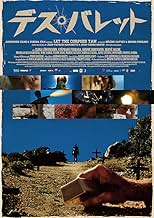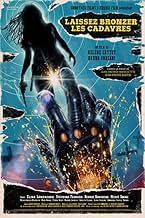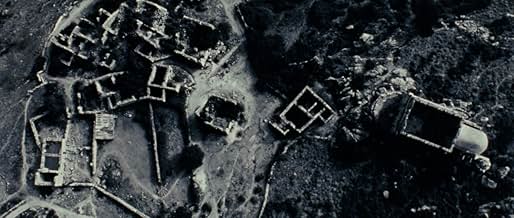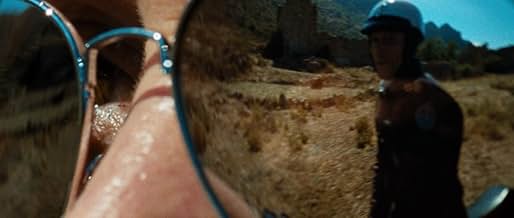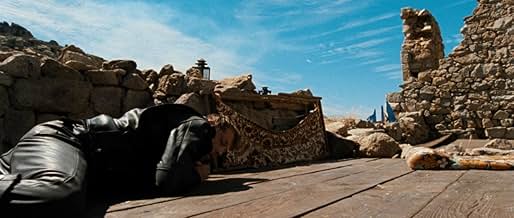IMDb-BEWERTUNG
6,2/10
3673
IHRE BEWERTUNG
Ein Ganove und seine Bande ziehen sich mit einer Beute von 250 Kilogramm Goldbarren auf eine Insel zurück, um dort unterzutauchen, doch ein böhmischer Schriftsteller, seine Muse und ein paar... Alles lesenEin Ganove und seine Bande ziehen sich mit einer Beute von 250 Kilogramm Goldbarren auf eine Insel zurück, um dort unterzutauchen, doch ein böhmischer Schriftsteller, seine Muse und ein paar Gendarmen verkomplizieren die Dinge.Ein Ganove und seine Bande ziehen sich mit einer Beute von 250 Kilogramm Goldbarren auf eine Insel zurück, um dort unterzutauchen, doch ein böhmischer Schriftsteller, seine Muse und ein paar Gendarmen verkomplizieren die Dinge.
- Auszeichnungen
- 4 Gewinne & 9 Nominierungen insgesamt
Marilyn Jess
- La policière
- (as Dominique Troyes)
Empfohlene Bewertungen
All style, no substance. It's extremely hard to follow after the setup establishes the theft of gold bullion, with some of the worst storytelling and worst character development I've ever seen. We never learn anything about these people, and have little idea who's shooting who over most of the film; meanwhile the directors give us pointless cuts back in time which add nothing, and the film quickly descends into unexplained scenes of sex, violence, crucifixion, and urination. This dreamy/nightmarish style leads to interesting imagery at times and the scenery in the ruins overlooking the azure waters of Corsica is striking, but mostly the film is an exercise in wild surrealism and a mashup of old film references that was more frustrating than compelling, at least for me.
Well, here's one issue we can discern right away: this film is blithely imitative. Nods or homages are one matter, but without a supple, delicate hand to guide the intention, any passing familiarity to other works or filmmakers is blunt and heavy-handed to the point of irritation. Not even ten minutes have passed and I see Ennio Morricone, Sergio Leone, Quentin Tarantino, David Fincher, Jay Rabinowitz, and more, recalled with a forcefulness that's distinctly off-putting. That forcefulness readily applies or extends to the direction, cinematography, editing, sound design, dialogue, acting, music, and effects, and arguably even to the production design, costume design, hair, and makeup. This isn't to say that 'Laissez bronzer les cadavres,' or 'Let the corpses tan,' can't still be enjoyable and worthwhile, but it's not an encouraging start, and the brusqueness, gawkiness, and flat-out aggressiveness of the project continues to be emphatically bothersome.
True, the filming locations are gorgeous. I do like the music selections themselves; would that the audio weren't so imbalanced, with the music egregiously high in the mix. Most bits and pieces here are just fine in and of themselves, in fact - or at least they are on paper, and would be in practice if they were approached with even the slightest sense of tact or nuance. Yet whether one wishes to attribute the tiresome zealousness of the presentation to filmmakers Hélène Cattet and Bruno Forzani alone, or also lay some responsibility on the shoulders of all other contributors, as we see it the picture is so impetuous and severe in its fundamental construction that it becomes taxing. By the time only one-third of the length has elapsed it feels like we've been watching for much longer. What it comes down to is this: there is earnest substance in 'Laissez bronzer les cadavres' as a violent thriller, but that substance is distinctly overwhelmed and almost entirely subsumed by the prioritization of Style, Style, Style. You've heard of "Location, Location, Location?" Well, here we are.
There's actually a lot to like here. Consider the root idea by itself, and we have a compelling, hard-charging action-crime flick on our hands, even if the discrete course of events is at most a tertiary concern. I recognize the skill and intelligence that shaped this feature, and that was poured into every component part. There are terrific ideas here, in pretty much every regard. I sharply disagree with the choices of how this was put together, however, including far too many embellishments that are supposed to lend flavor but which instead just come off as self-indulgent excess, especially in light of the general ethos behind the craftsmanship. I suppose it's also worth mentioning that the movie isn't very good at introducing or identifying characters, though in fairness this facet hardly matters; the violence, murder, and betrayal are clear enough without elucidation in the script of who is who, or where exactly their allegiances lie. More troubling is that some narrative elements go completely unexplained as they present; who is "the golden woman?" Beats me.
Factor in frenetic pacing in the direction and deliberately disjointed sequencing, and the unfortunate result is that the genuine value that 'Laissez bronzer les cadavres' has to offer is at best equaled and at worst far outweighed and dampened by Cattet and Forzani's extreme favor of flashy zest and flair over function, let alone mindfulness. There really is a lot that's done well here, but the sad truth is that the filmmakers' impulses needed to be significantly reined in, and the entertainment is not only reduced by the underlying slant but also specifically takes hits from those ways in which the presentation is heedlessly overdone. I assume that the novel this is based on is more lucid; I certainly hope so, at least, for the sake of Jean-Patrick Manchette and Jean-Pierre Bastid. One way or another, the fate of this 2017 picture is sealed. By all means, I'm glad for those who get more out of this and think it's a really great time, but I'm much less than fully convinced. For what it's worth, I look forward to checking out more from all involved, if only out of curiosity, yet 'Laissez bronzer les cadavres' itself is best reserved for a niche audience of which I am not part.
True, the filming locations are gorgeous. I do like the music selections themselves; would that the audio weren't so imbalanced, with the music egregiously high in the mix. Most bits and pieces here are just fine in and of themselves, in fact - or at least they are on paper, and would be in practice if they were approached with even the slightest sense of tact or nuance. Yet whether one wishes to attribute the tiresome zealousness of the presentation to filmmakers Hélène Cattet and Bruno Forzani alone, or also lay some responsibility on the shoulders of all other contributors, as we see it the picture is so impetuous and severe in its fundamental construction that it becomes taxing. By the time only one-third of the length has elapsed it feels like we've been watching for much longer. What it comes down to is this: there is earnest substance in 'Laissez bronzer les cadavres' as a violent thriller, but that substance is distinctly overwhelmed and almost entirely subsumed by the prioritization of Style, Style, Style. You've heard of "Location, Location, Location?" Well, here we are.
There's actually a lot to like here. Consider the root idea by itself, and we have a compelling, hard-charging action-crime flick on our hands, even if the discrete course of events is at most a tertiary concern. I recognize the skill and intelligence that shaped this feature, and that was poured into every component part. There are terrific ideas here, in pretty much every regard. I sharply disagree with the choices of how this was put together, however, including far too many embellishments that are supposed to lend flavor but which instead just come off as self-indulgent excess, especially in light of the general ethos behind the craftsmanship. I suppose it's also worth mentioning that the movie isn't very good at introducing or identifying characters, though in fairness this facet hardly matters; the violence, murder, and betrayal are clear enough without elucidation in the script of who is who, or where exactly their allegiances lie. More troubling is that some narrative elements go completely unexplained as they present; who is "the golden woman?" Beats me.
Factor in frenetic pacing in the direction and deliberately disjointed sequencing, and the unfortunate result is that the genuine value that 'Laissez bronzer les cadavres' has to offer is at best equaled and at worst far outweighed and dampened by Cattet and Forzani's extreme favor of flashy zest and flair over function, let alone mindfulness. There really is a lot that's done well here, but the sad truth is that the filmmakers' impulses needed to be significantly reined in, and the entertainment is not only reduced by the underlying slant but also specifically takes hits from those ways in which the presentation is heedlessly overdone. I assume that the novel this is based on is more lucid; I certainly hope so, at least, for the sake of Jean-Patrick Manchette and Jean-Pierre Bastid. One way or another, the fate of this 2017 picture is sealed. By all means, I'm glad for those who get more out of this and think it's a really great time, but I'm much less than fully convinced. For what it's worth, I look forward to checking out more from all involved, if only out of curiosity, yet 'Laissez bronzer les cadavres' itself is best reserved for a niche audience of which I am not part.
The people who are giving this really bad reviews must be knuckle draggers. This is a very unique and interesting flawed thriller. Flawed because is a little hard to follow with all the time jumps and inserted symbolism.
But if you stick with it you should be rewarded with a very interesting layered movie like you have not seen in a long long while.
It's a thinking man's (or woman's) movie. Pay attention.
But if you stick with it you should be rewarded with a very interesting layered movie like you have not seen in a long long while.
It's a thinking man's (or woman's) movie. Pay attention.
I believe that people will enjoy this film in direct proportion to two things: your appreciation for bravura cinematic style, and your hard-wired facial recognition talents. The two collide immediately, as we are introduced to some of the characters (I think) via extreme closeups of eyes and mouths. The filmmakers avoid all of the usual techniques for establishing character identity and relationships, especially among members of the gang. I can't honestly say that I know what happened in the film's last third: who betrayed whom, who was firing what weapons, and so on.
In the meantime, though, I saw things, cool things, good things, that I'd never seen before on a movie screen. The stylistic flourishes kept me just engaged enough to not walk out. In the end I'm glad I saw it and even more glad that I didn't pay for a ticket (I have a membership at the local arthouse cinema). Mostly I'm frustrated, because if the filmmakers would put storytelling first and then maximize style as much as possible (like, you know, every other filmmaker on the planet) rather than vice versa, this could have been a kinky classic.
In the meantime, though, I saw things, cool things, good things, that I'd never seen before on a movie screen. The stylistic flourishes kept me just engaged enough to not walk out. In the end I'm glad I saw it and even more glad that I didn't pay for a ticket (I have a membership at the local arthouse cinema). Mostly I'm frustrated, because if the filmmakers would put storytelling first and then maximize style as much as possible (like, you know, every other filmmaker on the planet) rather than vice versa, this could have been a kinky classic.
A road gang hijacks a gold shipment, kills the driver and escorts, then hides out at a picturesque seaside retreat occupied by an artist and her retinue.
More unexpected and unwanted visitors arrive. So do the cops. Much gunfire, double dealing, and bloodshed occur along with weird and surreal erotic dreams interspersed with action.
That's the movie in a nutshell. What propels it far beyond the blood-and-gore 70s Italian exploitation flicks it seems to emulate is everything else: photography, acting, editing, sound (someone obviously has a fetish for creaking leather clothing), and scenery.
Ah, the scenery! A crumbling seaside Mediterranean cluster of decrepit interconnected walls and broken down church are so much a part of the action one can almost imagine them taking cues from the director.
It doesn't always make sense. This is partly due to sparse subtitling (it's in French) and partly to the simple fact that at times it's almost impossible to keep track of who are the "good" guys and who are the "bad" guys. (Not that it makes a difference!)
But cinematically this film is a real hoot especially if you enjoy occasional off-the-wall movie nonsense produced to sound and look like High Art despite the underlying tenuous threads of a plot.
Recommended. Sort of.
More unexpected and unwanted visitors arrive. So do the cops. Much gunfire, double dealing, and bloodshed occur along with weird and surreal erotic dreams interspersed with action.
That's the movie in a nutshell. What propels it far beyond the blood-and-gore 70s Italian exploitation flicks it seems to emulate is everything else: photography, acting, editing, sound (someone obviously has a fetish for creaking leather clothing), and scenery.
Ah, the scenery! A crumbling seaside Mediterranean cluster of decrepit interconnected walls and broken down church are so much a part of the action one can almost imagine them taking cues from the director.
It doesn't always make sense. This is partly due to sparse subtitling (it's in French) and partly to the simple fact that at times it's almost impossible to keep track of who are the "good" guys and who are the "bad" guys. (Not that it makes a difference!)
But cinematically this film is a real hoot especially if you enjoy occasional off-the-wall movie nonsense produced to sound and look like High Art despite the underlying tenuous threads of a plot.
Recommended. Sort of.
Wusstest du schon
- WissenswertesDario Argento's Deep Red (1975) famous soundtrack is used.
- VerbindungenReferences Von Angesicht zu Angesicht (1967)
Top-Auswahl
Melde dich zum Bewerten an und greife auf die Watchlist für personalisierte Empfehlungen zu.
- How long is Let the Corpses Tan?Powered by Alexa
Details
Box Office
- Bruttoertrag in den USA und Kanada
- 93.409 $
- Eröffnungswochenende in den USA und in Kanada
- 11.918 $
- 2. Sept. 2018
- Weltweiter Bruttoertrag
- 93.409 $
- Laufzeit1 Stunde 32 Minuten
- Farbe
- Seitenverhältnis
- 2.35 : 1
Zu dieser Seite beitragen
Bearbeitung vorschlagen oder fehlenden Inhalt hinzufügen

Oberste Lücke
What is the Spanish language plot outline for Leichen unter brennender Sonne (2017)?
Antwort



